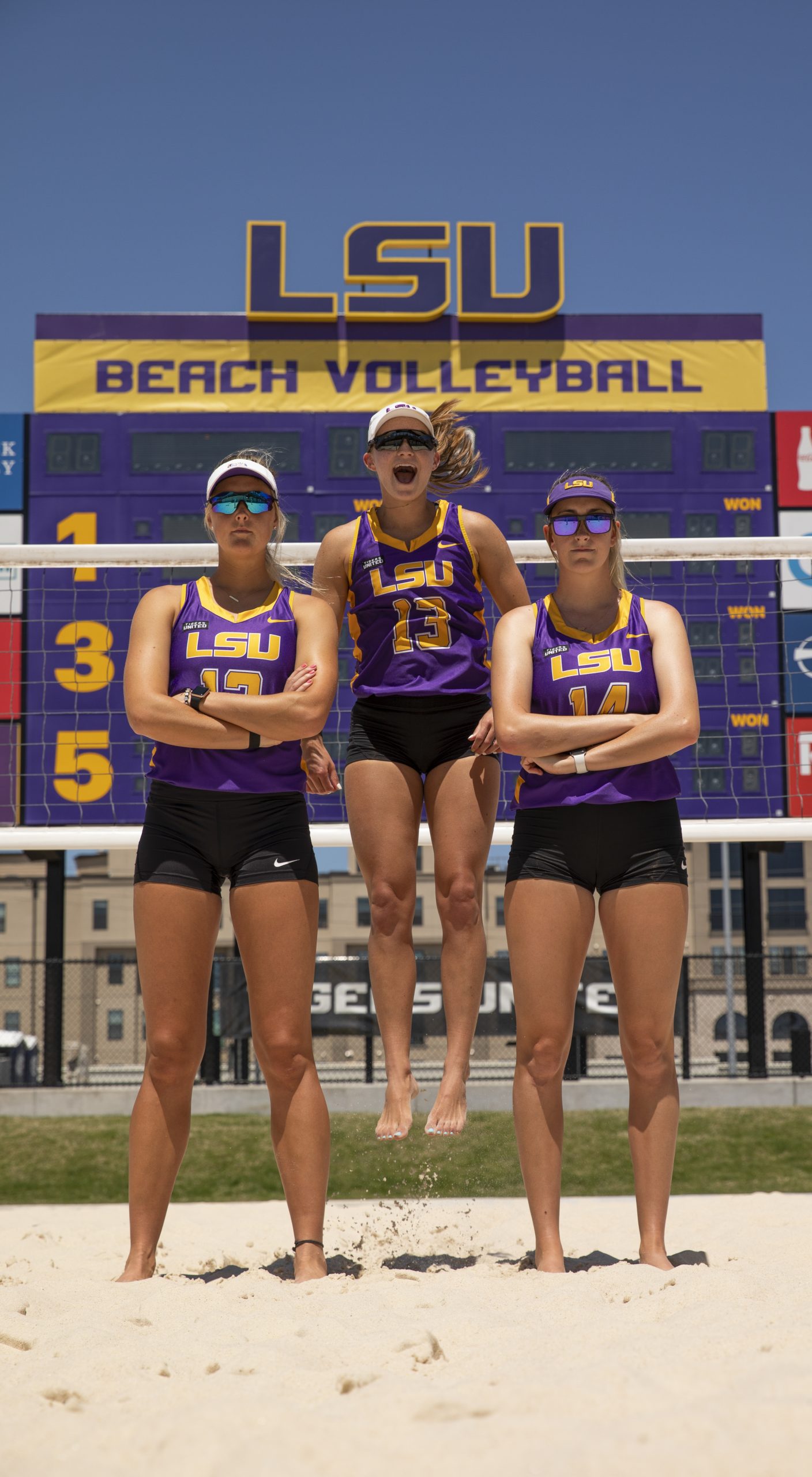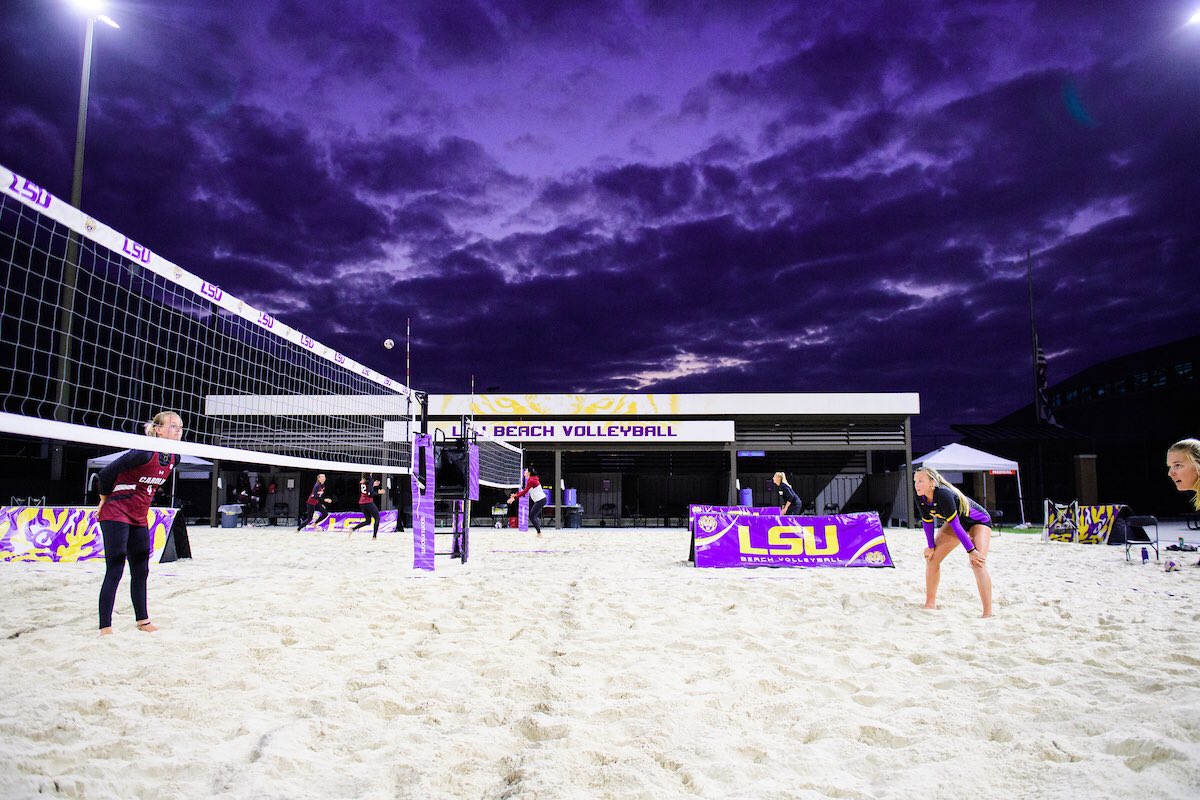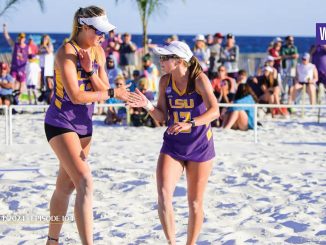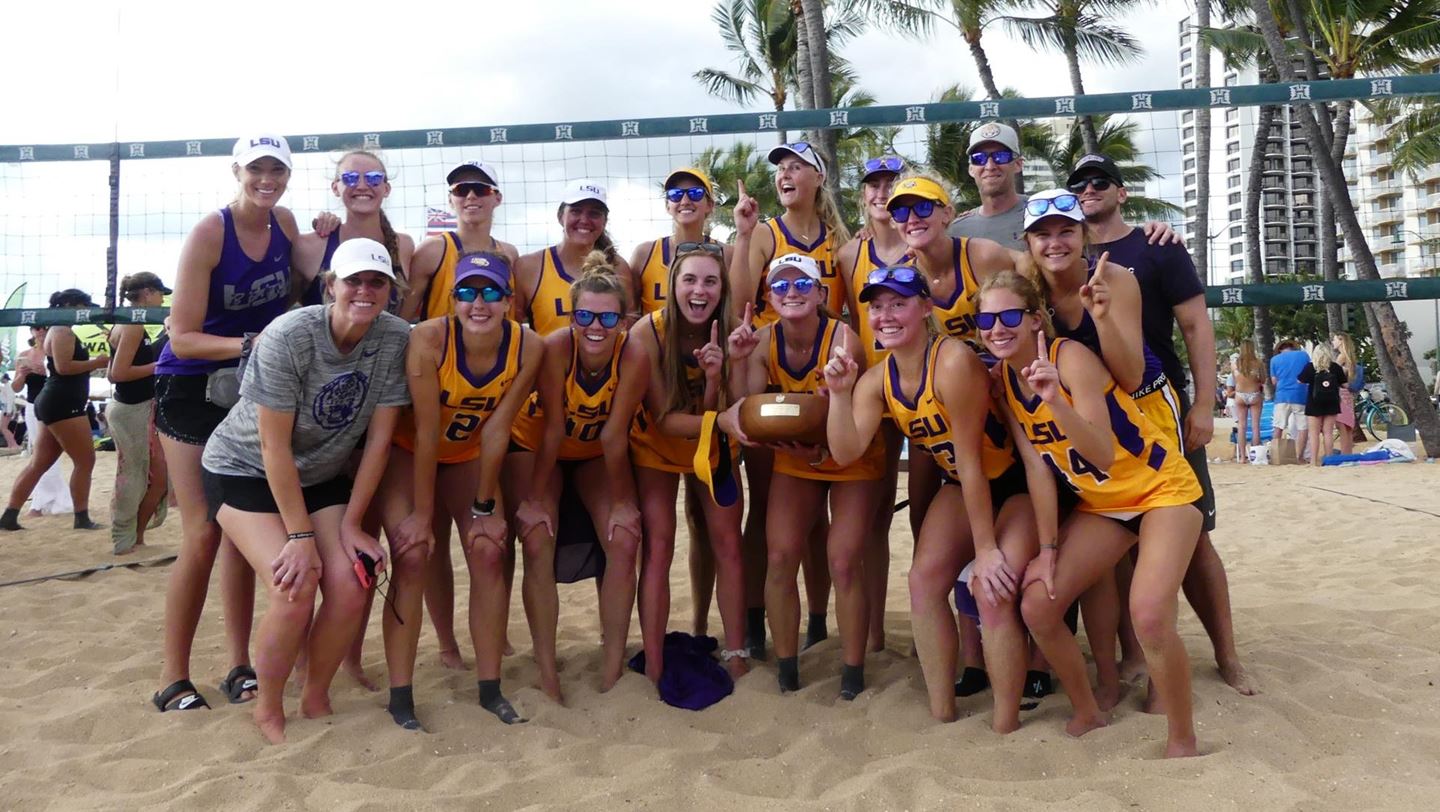
This story is in the Tiger Rag Magazine May “Women in Sports” 2021 issue available Thursday at the usual outlets
It was born from opportunity.
“My passion is more chances for females,” LSU head volleyball coach Fran Flory said.
Faith formed the foundation.
“I truly believed it was the type of place that could develop into one of the best programs in the country,” Tigers’ head beach volleyball coach Russell Brock said.
Work ethic accelerated growth.
“Just every single day, we’ve pushed each other to become the very best version of ourselves,” LSU senior Kristen Nuss said.
Identity emerged.
“What binds us is a culture where people value the team above itself, we all want to play for each other, not ourselves,” LSU senior Claire Coppola said.
Finally, it became a family, a unique blend of talents and personalities who sweat, laugh, cry and dance to music daily in the sand of their on-campus playing palace.
“We’re just a bunch of misfits,” said Tigers’ assistant coach and former LSU beach standout Cati Leak, “that has fun while enjoying competing in different settings and expecting each other to be great.”
On May 7-9 on the Alabama beaches of Gulf Shores for the fourth straight time (discounting last year’s COVID-19 shortened season), LSU’s fourth-ranked beach volleyball program will be one of eight teams batting for the NCAA national championship.
By any measure, four consecutive trips to the pinnacle of college beach volleyball is a heady accomplishment.
But consider the Tigers just started their beach program eight seasons ago in 2014 and were already playing for a national title in year four in 2017 against geographically advantaged powerhouses UCLA, USC and Florida State.
So, how exactly did a landlocked university almost overnight reserve an annual reservation in the college beach volleyball penthouse with schools located on the beach game doorstep?
Fran and a man with a plan
LSU sponsors 11 women’s sports. The first nine (starting with gymnastics) began in a seven-year period between 1975-81. It took 14 years before soccer was added and another 19 years before the Tigers began their beach program.
Late in 2012 or early 2013 – Flory can’t quite recall exactly when – the American Volleyball Coaches Association pushed coaches to create more beach programs to increase opportunities for women’s athletes.
In 2011-12, there were 15 NCAA Division 1 beach teams (there now 69). Flory wanted LSU to be among the early wave of colleges adding beach as a sport.
“I viewed it as paying it forward,” said Flory, who just finished her 22nd year at LSU. “Somebody in women’s athletics started indoor volleyball without getting paid much and without notoriety. They started it because they wanted to provide opportunities and that is my platform for beach. I wanted to start beach because somebody did this for me a long time ago.
“And to tell the truth, I promised we’d have a beach team to an in-state recruit named Katie Lindelow, who’s now a professional beach player. I told her if she came to LSU, she would be our first dual surface player.”
So, Flory took her cause to then-LSU athletics director Joe Alleva.
“Joe, we probably need some consideration to add a female sport,” Flory told Alleva. “I would like to suggest beach volleyball. I’ll coach it for free, I just want to start it. I’m not asking for money, just opportunities for women. It’s a sport we can win a national championship here.”
“Really?” Alleva replied.
“Yes, we’re the perfect footprint,” Flory confirmed. “This could be pretty special.”
In August 2013, Alleva called Flory and said he wanted to immediately start a beach program using some of the indoor team players that would play its first season the following spring.
Flory and assistant Jill Wilson picked five players from an open campus tryout and trained them from 6 to 8 in the morning during the indoor fall season while the afternoons were reserved for indoor team practice.
It was exhausting and Flory quickly realized she had to hire an assistant who would take over the beach program.
Over the years, Rice University in Houston had frequently popped up on LSU’s indoor schedule. Flory became acquainted with Owls’ assistant coach Russell Brock, a Baytown, Texas native who played collegiately at Southern Cal where he was the school’s all-time digs leader. He was also someone who had played his share of beach volleyball in an area considered the hotspot of the beach universe.
She hired him away from Rice in January 2014 less than two months before LSU’s first-ever beach match.
“Russell was the right guy at the right time,” Flory said. “He experienced volleyball at the highest level as a player and as a coach. He had a skill set for both indoor and beach.
“He’s also maybe the best person that I’ve ever been around in my life. He builds great people. You can see that in the love his former and current players have for him.
“And because beach volleyball is played in pairs, you have to have somebody who can manage relationships. I felt he could really manage relationships.”
After the first beach season when LSU finished 6-10, Brock seemingly had nothing to sell in recruiting.
Facilities?
The Tigers practiced and played their home matches in Mango’s, a beach volleyball complex/bar built in 1995 by owner Tim Bourgeois and wife Tina.
It’s plopped in the middle of a South Baton Rouge neighborhood off South Sherwood Forest Boulevard, more than 9 miles from the LSU campus. That doesn’t seem far, but players had to navigate through congested mid-afternoon Baton Rouge traffic to arrive on time for practice.
Beach volleyball tradition? None.
“It was impossible at that point to have a (beach) history, but I had a clear vision and timeline,” the 48-year-old Brock said. “I knew if we could get the right players – we needed people who were efficient, well-balanced and passionate about being excellent in the sport and in life, and who had skill sets to become beach players – that I had confidence we could teach the game in a way that would allow us to be successful.”
The conversion
With two players on each side of the net as opposed to six players to a side in indoor play, beach players use every volleyball skill in their tool box – defend, set, hit, serve. They have to slog through sand instead of gliding over hard indoor surfaces.
A major part of Brock’s recruiting plan has been taking advantage of an NCAA rule that allows an athlete, whether they’ve graduated or not, to play four years in one sport and then become immediately eligible to play a different sport in a fifth year of eligibility.
Sometimes, if an athlete happens to graduate in 3½ years, they can get two full seasons in a different sport.
“Russell has made a living off this rule because there are so many indoor players who just want to experience the sand,” Flory said. “Credit him for being strategic to benefit from it.”
LSU’s rise to a national title contender and its three-year old volleyball stadium re-fitted from the previous LSU tennis stadium – “It’s the best beach facility in the country, we set the standard,” Flory said – has made the Tigers’ beach program and their homecourt nicknamed “Death Volley” (on which it has a 31-1 record) a destination for transfers such as current seniors Taryn Kloth (Creighton) and Jess Lansman (Iowa State).
Many players credit the coaching staff for their successful indoor to beach conversion, especially giving kudos to long-time volunteer assistant Drew Hamilton who Brock calls “one of the greatest volleyball minds in the country.”
“When I got to LSU, Drew Hamilton literally taught me everything I know about beach volleyball,” said Nuss, a former multi-sport standout for Mount Carmel Academy in New Orleans.
Nuss, who measures just 5 feet, 6 inches, is the winningest player in NCAA beach volleyball history with 135 wins and counting.
She’s a few spots ahead of her former Court 1 partner Coppola who has 121 wins as the fourth winningest NCAA beach player ever. Senior Oiivia Ordonez-Powers, another member of the program’s benchmark 2017 recruiting class and one of the team’s two married players, has 83 career wins.
After Nuss and Kloth played together and won tournaments last summer, Brock shook up his lineup this season. He broke up the three-year Nuss/Coppola dynamic duo and paired Nuss with Kloth.
The result? They are 32-0 with 29 wins in straight sets.
“When people look across the net and see me playing next to Taryn who’s 6-4, I look so tiny and short,” Nuss said. “If we’re walking around anywhere, people always look at Taryn and say `You must play a sport.’
“People would not expect me to play beach volleyball. I’ll think I’ll forever play with a chip on my shoulder proving people wrong and letting my game speak for itself. I like my 5-6.”
Nuss’ capacity for in-match strategy adjustments (“She understands this game like no one else,” junior Ashlyn Resnick-Pope said), her effortless acceleration and direction changes through sand (“Part of is natural athletic talent, she can school you in just about any sport,” Coppola said), her knack of lifting teammates (“She makes everything simple,” Kloth said) and her relentless pursuit of excellence (“She’s never going to be satisfied,” senior Toni Rodriguez said) – is why Nuss is the exact demographic of what Brock pursues in recruiting.
Past national champions such as Southern Cal and UCLA are filled with in-state players. While there may be a part of Brock that wishes his roster all could be California girls, that’s not the D.N.A. of his program.
“We look in places maybe like us,” Brock said. “It’s not logical to think they’re great recruits coming from Arizona or the Midwest or from Louisiana.”
Leak, who was recruited to LSU as an indoor player and who played on the Tigers’ first four beach teams from 2014 to 2017, said character is a key element in Brock’s recruiting philosophy.
“We watch prospects’ interactions with their teammates and their parents,” Leak said. “How do they respond when they lose? We get to know the club coaches and their body language when they talk about a kid. Sometimes, those cues and nonverbals seal the deal.”
The consistent, solid behavior has created a family atmosphere that’s prevalent when a beach prospect takes an official recruiting visit to LSU.
“I come from a very loving and hugging family,” said Kloth, a Sioux Falls, S.D. native. “Right when I got off the plane on my visit, (former LSU assistant) Trey (Cruz) gave me a hug and Russell did when I met him. I’m like, `Oh my gosh, this is so cool.’”
Lansman said she immediately noticed on her visit how the players interacted.
“I was like `Wow, there’s something about this team that sets it apart from any other team I’ve ever seen,’” she said. “We genuinely care and love each other. I’ll have these lifelong friends forever.”
It’s why Lansman, taking advantage of the NCAA’s COVID-19 related offer of giving all athletes another year of eligibility, returned for one last seaso. She left a teaching job in Kearney, Neb. where her new husband was playing football for the University of Nebraska-Kearney.
“I still had a little bit of unfinished business at LSU,” Lansman said.
Every senior from last year’s team felt the same because they all returned for this season. When they gathered for Senior Night after April 10 at a three-match day at Death Volley, the occasion’s finality filled their hearts.
They realized their time together was growing short.
Coppola has a job waiting for her in Southern California selling medical devices for athletes undergoing orthopedic sports surgery. Lansman is set to return to teaching in Nebraska. Nuss, Kloth and Rodriguez, a seventh-year senior with two knee surgeries to match her two master’s degrees, all want to pursue pro careers before transitioning into coaching. Ordonez-Powers has been hired as director of a beach volleyball juniors club just outside of Houston.
“On Senior Night, we were all there at the stadium for an hour and a half after the thing ended,” Leak said. “None of us wanted to leave. We just wanted to celebrate what that group had done. They all genuinely love each other.”
Role reversal
When the 2020 season unexpectedly ended because of the COVID-19 pandemic after 14 matches, the Sandy Tigs were just hitting their stride.
They were 12-2, ranked No. 1 in the nation and just two weeks removed from a 3-2 home win over previous No. 1 UCLA before an all-time NCAA beach volleyball on-campus record crowd of 2,407.
“I honestly couldn’t have dreamed of this,” Brock said at the end of that glorious Saturday night when his team took down the top-ranked Bruins before a packed house.
Flory, who was on the road recruiting, said she was emotional when she learned of what transpired – a rowdy, sellout on-campus crowd watching beach volleyball.
“It’s exactly what I thought would happen,” she said.
Such a grand moment earned a chunk of respect nationally for a program that had long been viewed as the interloper among the sport’s bleached-blonde bluebloods.
“The first time we went to nationals, we got the reaction of `How they are here from the middle of nowhere Louisiana?’,” Coppola said.
Nuss remembered being asked at nationals by a reporter, “So, your team practices and plays its games at a bar near an interstate?’”
This year when LSU was named preseason No 1, it could no longer tap into its underdog role. The hunters became the hunted and it has been an adjustment for the 25-7 Tigers.
But as Brock has continuously reminded his team during its rise to national prominence, there is plenty of space in the LSU trophy case.
“We don’t have any significant hardware,” Brock said “Our goals from the inception of the program were never to be No. 1 in the polls. They always has been to win a conference championship, win a national championship.
“Our main goals are still unachieved. We don’t feel technically we’ve accomplished anything yet or that our program has arrived.”




Be the first to comment